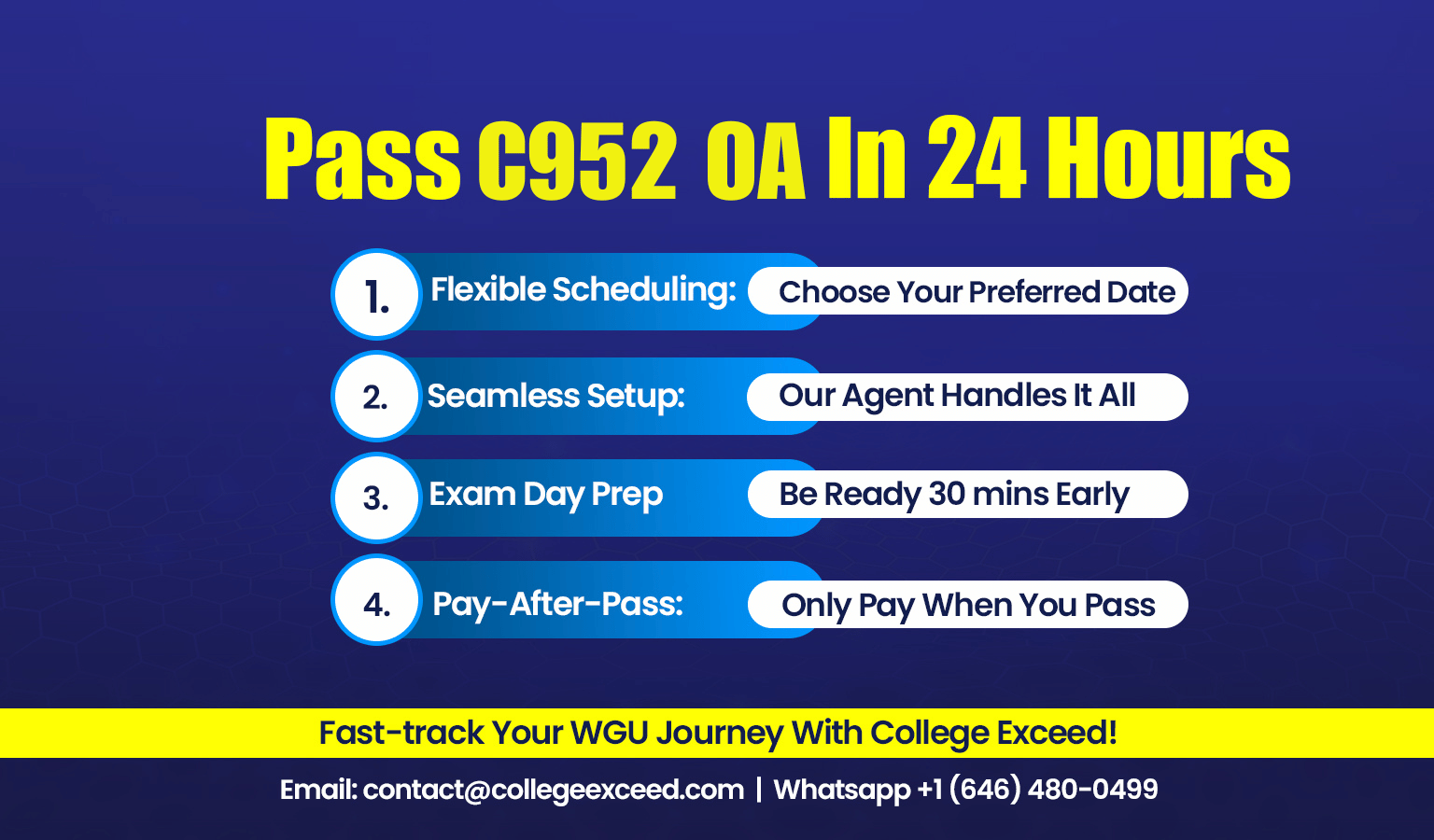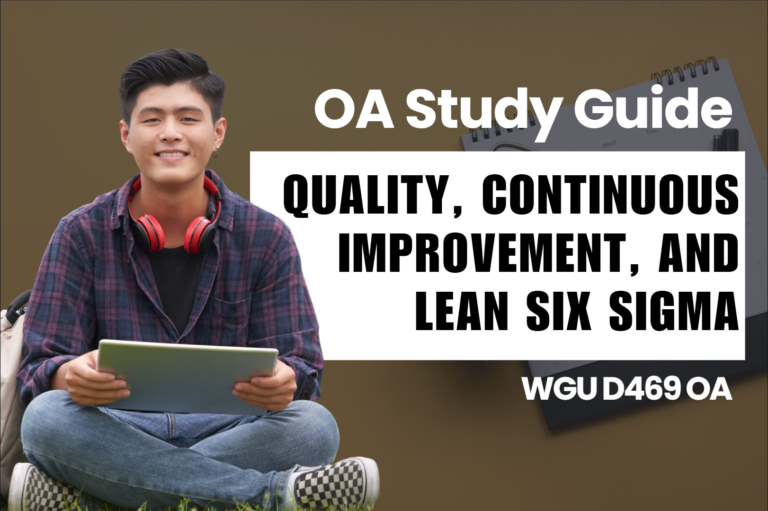Hello and congratulations on finding the ultimate tutorial that will help you succeed in Computer Architecture WGU C952 at Western Governors University (WGU)! If you have been looking for the best technique on how to study for this course and pass then luck is on your side since you are here. Let’s take you through all the information you require to easily solve C952 in this article. If you are concerned about the math part or if you don’t know how you are going to manage your time in school, don’t worry we have got you covered for everything.
To explain to you more about this, below are the elements of this guide covering the C952 module: The Highlights: This part will describe the expectations that one is likely to have concerning the C952 module Learner’s Daily Program for a Week before the OA: Basically, this part will outline a weekly program that a user needs to follow to ensure they score well in the OA Free Resources for Tough Concepts in C952 Module: This part of the This also includes consideration of the matters which need to be emphasized and possible questions, one could stumble upon as they progress through the course. At the end of this course, you will have all the strategies pointed out that you need to score well on Computer Architecture at WGU.
Now, it is high time to explore what is awaiting you with this course, and also, what preliminary steps you can or should take.
...
An Overview of What to Expect in WGU C952📖
Welcome to Computer Architecture (C952) at WGU, a course designed to introduce you to the intricate details of how modern computer systems are organized and how they function. This module covers everything from the basics of computer architecture design to the interactions between hardware and software, all with the goal of optimizing system performance, efficiency, and overall design.
In this course, you’ll dive into several key areas:
- Computer Architecture Design: Here, you’ll learn how to assess the impact of various hardware and software design choices. Factors like cost, performance, power consumption, and compatibility will all come into play as you evaluate ways to improve the quality and capabilities of a system.
- Operating Systems: This section explores the purpose and functions of operating systems and their critical role in computer architecture. You’ll analyze how operating systems interact with computer hardware to manage resources efficiently.
- Computer Architecture: You’ll evaluate the characteristics of different computer architectures and learn how these features can be leveraged to meet specific business objectives. This knowledge is essential for making informed decisions in system design.
- Information System Solutions: In this part of the course, you’ll analyze the impact of computer architecture choices on information systems. Understanding these choices will help you effectively communicate and apply design considerations within an organization.
- Hardware and Software Interaction: Finally, you’ll focus on how hardware and software interact to maximize system performance. This section will require you to evaluate these interactions critically, understanding how they affect the overall capabilities of a system.
What to Watch Out For
- Pacing and Time Management: Most students complete this course within 4-5 weeks and successfully pass the Objective Assessment (OA) on their first attempt. Staying on track with the pacing guide provided at the beginning of the course is key to managing your time effectively.
- Focus on Vocabulary: Approximately 70% of the course will be dedicated to vocabulary and conceptual understanding. Pay close attention to terms and definitions, as a strong grasp of this material will be crucial for success.
- Performance Improvement Concepts: The course places a strong emphasis on understanding concepts that can improve system performance. Make sure to pay special attention to these areas as they are heavily tested.
- Technical Questions: About 30% of the OA will focus on more technical, detail-oriented questions. You’ll need to be comfortable with binary calculations, interpreting assembly instructions, CPU performance calculations, and pipelining questions (such as calculating total time and average time).
As you progress through the course, especially in the “Real Stuff” sections, it’s a good idea to keep track of key dates and events discussed. This will help solidify your understanding of the material and ensure you’re well-prepared for the exam.
WGU C952 Study Guide to Navigate the Module📝
Week 1: Introduction and Textbook Overview
- Watch the Introduction Video: Start by watching the course’s introduction video to get a clear understanding of what you’ll be covering. This will set the stage for your study journey.
Location: Go to the Student Portal of WGU > Log onto your profile > Go to the C952 Module page > Click on the “Course Tips” - Read the Textbook: Begin reading the textbook, focusing on chapters 3, 6, and 7, as these are crucial for the exam. While the textbook is extensive, the exam is more broad, so concentrate on understanding significant concepts in context, particularly with a focus on optimization. Don’t get bogged down by overly detailed sections; if something feels too complex and unrelated to optimization, it’s okay to move on. Use the terms and definitions document to assist with your studies. This document will help you keep track of key terms that will appear in the exam.
Location (Textbook): Go to the Student Portal of WGU > Log onto your profile > Go to the C952 module page > Click on the “Go to course materials”
Location (Terms and Definitions): Go to the Student Portal of WGU > Log onto your profile > Go to the C952 Module page > Click on the “Course Chatter” > In the Group files find the document “C952- Computer Architecture glossary.pdf”
Week 2: Deep Dive into Important Concepts
- Focus on Chapters 3, 6, and 7: Revisit these chapters and ensure you understand the critical concepts. These chapters cover the core material that will be heavily tested in the Objective Assessment (OA).
- Use Supplementary Materials: Review any supplementary materials provided in the course, especially the terms and definitions document. Understanding these terms in context is crucial, as vocabulary plays a significant role in this course.
- Pre-Assessment (PA) Preparation: Consider taking the pre-assessment now to gauge your current understanding. This will help you identify areas that need more attention. Remember, the OA is broad, but the PA can be a good predictor of how well you’ll perform on the final exam.
Week 3: Engage with Interactive Content
- Watch the Webinar Recordings: These recordings will reinforce your understanding of the material covered in the textbook. Webinars often present the content in a more digestible and interactive way, making it easier to grasp complex concepts.
Location: Go to the Student Portal of WGU > Log onto your profile > Go to the C952 Module page > Click on the “Course Search” > Open “C952 Computer Architecture Course Home Page”> Scroll down until you find “Prof Jack Lusby’s webinars” - Pre-Assessment Review: If you’ve taken the PA, review your results and focus on areas where you struggled. Pay special attention to vocabulary and key concepts that appeared in the PA, as they are likely to show up in the OA as well.
Location: Navigate to the same location as above and scroll down to find “pre-assessment question videos – Videos for pre-assessment questions”
Week 4: Final Review and Pre-Assessment Retake
- Review Assembly Code Like Pseudocode: Don’t stress over the differences between LEG and ARM architectures. Focus on understanding basic operations like ADD, SUB, and branching, and how they relate to higher-level code. Treat assembly code as pseudocode to simplify your study process.
- Master Computational Problems: CPU time problems are critical and often mirror those on the PA. Make sure you’re comfortable with these types of questions. You don’t need to memorize every formula, but you should be able to solve these problems accurately.
- Retake the Pre-Assessment: If possible, retake the PA to check your progress. This will give you a final boost of confidence before you tackle the OA.
Week 5: Objective Assessment (OA)
- Final Preparation: Review any remaining areas where you feel uncertain. Focus on understanding the big picture rather than memorizing details. The OA is broader but not as deep as the textbook, so concentrate on key concepts.
- Take the OA: Approach the exam with confidence, knowing that you’ve thoroughly prepared. Remember, while the OA is broader, it’s manageable if you’ve focused on the right areas throughout your study plan.
Following this study plan will help you systematically prepare for the C952 exam, ensuring that you’re well-equipped to pass on your first attempt.
...
External Resources to Study for C952 OA👨🏻🏫
∙ Quizlet Flashcards:
- WGU C952Flash Cards: This set of flashcards is specifically tailored to the C952 Computer Architecture course. It covers key terms and concepts that are crucial for the Objective Assessment (OA). Flashcards are a great way to reinforce your vocabulary, which is a significant portion of the exam.
- C952Computer Architecture Flash Cards: Another set of Quizlet flashcards focusing on Computer Architecture. These cards provide a quick review of essential concepts and definitions, making them a perfect tool for quick study sessions.
∙ YouTube Channels:
- David Black-Schaffer YouTube Channel: David Black-Schaffer is a professor who specializes in computer architecture and related topics. His YouTube channel offers a series of lectures and tutorials that align closely with the content covered in the C952 course. His clear explanations and real-world examples make complex topics easier to understand.
- The Organic Chemistry Tutor: While the name might suggest a focus on chemistry, this channel also offers excellent videos on a variety of topics, including computer science. The videos on binary calculations, CPU performance, and other foundational concepts in computer architecture are particularly useful.
∙ Khan Academy:
- Khan Academy Computing and Internet: Khan Academy offers comprehensive, free lessons on various computer science topics, including computer architecture. Their interactive exercises and detailed explanations make it a great resource for reviewing complex concepts like CPU performance and binary calculations.
...
Key Topics to Focus on📂
When preparing for the C952 Objective Assessment, there are several crucial areas you need to focus on. Below is a streamlined guide to help you prioritize your study efforts.
Essential Calculations:
- Pipelining
- CPI (Cycles Per Instruction)
- Binary Conversions
- C/C++ Language/Assembly
Assembly Instructions:
- Study the assembly instructions thoroughly; expect around 10 questions on this topic alone.
- Focus on reading and interpreting binary, as well as basic binary arithmetic (addition and subtraction).
Vocabulary:
- Caches
- Virtual Memory/Machines
- Parallel Processing
Familiarity with these terms will help you answer questions purely based on word recognition and process understanding.
Performance Calculations:
- Be prepared for questions on pipelining and CPU time.
- Know how to calculate performance using clock rate and clock cycles.
Practice Files/Videos:
- Focus on reading assembly code, performing binary math, and solving CPU execution time problems. The practice files and videos provided in the course are invaluable for mastering these skills.
Quizlet in Learn Mode:
- Use the Quizlet flashcards, especially in Learn mode, to drill vocabulary. This will help you identify which terms need further review.
Additional Notes:
- You might encounter a couple of questions on obscure ARMv8 instructions/categories—use the process of elimination for these.
- There will be some questions on the history of computers. Review this material but don’t spend too much time on it.
By focusing on these topics and using the resources mentioned, you can streamline your study efforts and be well-prepared for the exam.
...
WGU C952 FAQ❓
Q: How difficult is the C952 exam compared to the course material?
- A: The exam is generally considered easier than the textbook content. The course material covers a wide range of topics in-depth, but the exam focuses on broader concepts with an introductory depth. If you concentrate on understanding the key concepts rather than memorizing every detail, you’ll be well-prepared.
Q: How important is it to understand assembly language for the exam?
- A: Understanding assembly language is quite important. Expect around 10 questions specifically related to assembly instructions. Focus on reading assembly code, basic operations like ADD and SUB, and how these instructions translate to higher-level code. Treat assembly code like pseudocode to simplify your study process.
Q: What should I focus on when studying binary math?
- A: You should focus on binary addition, subtraction, and conversions. The exam will test your ability to interpret binary numbers, but it won’t require complex binary arithmetic. Make sure you’re comfortable with these basics, as they form the foundation for other topics like CPU performance calculations.
Q: How should I approach studying for the vocabulary-heavy sections?
- A: Vocabulary is a significant part of the exam, with around 70% of the questions focused on terms and concepts. Use Quizlet in Learn mode to review and reinforce your understanding of key terms. Pay special attention to vocabulary related to caches, virtual memory, and parallel processing.
Q: How can I best prepare for the computational problems on the exam?
- A: The computational problems, particularly those related to pipelining, CPI, and CPU execution time, are essential. Practice solving these types of problems using the course’s practice files and videos. Understanding the formulas and knowing when and how to apply them will be crucial.
...
Conclusion📄
Passing the C952 course at WGU may seem challenging at first, but with the right approach, you can navigate it successfully. This guide has provided you with a clear roadmap, focusing on the most critical aspects of the course, such as understanding assembly language, mastering binary math, and getting a firm grip on vocabulary. The key to success lies in balancing your study time between these areas, utilizing resources like Quizlet and YouTube, and taking advantage of the pre-assessment to identify and strengthen any weak spots.
Remember, while the course material is extensive, the exam itself is more about understanding broad concepts rather than getting lost in the details. Prioritize the topics we’ve highlighted, stay consistent with your study plan, and make sure to review the computational problems and key terms regularly. With thorough preparation and a strategic approach, you’ll be able to tackle the Objective Assessment with confidence and pass it on your first attempt.






